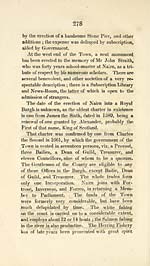Descriptive account of the principal towns in Scotland
(301) Page 279
Download files
Complete book:
Individual page:
Thumbnail gallery: Grid view | List view

279
and success, and the quantity cured, amounts from
17 to 18,000 barrels per annum.
The exports of Nairn consist chiefly of the pro-
duce of the different Fisheries, and of Fir wood, from
the extensive woods and plantations of the county. The
imports are Coal, Lime-stone, and Merchant goods.
The Town of Nairn has undergone some local chan-
ges ; it was originally situated about half a mile from
the spot where it now stands, and was defended by a
castle ; the ruins of which are now covered by the
sea, so that only the foundation of it is visible in neap
tides. This ancient castle was a royal fort in the
reign of Malcolm the First.
Nairn formerly gave the title of Baron to the family
of Nairn, attainted for their concern in the rebellion
in 1745.
The weekly Market-day is Friday, and there are an-
nual Fairs on the 1 8th day of February, on the first
Tuesday in March, the first Friday in June, on the 26th
day of July, if on a Wednesday, the first Friday after
the 28th of September O. S., on the 10th day of Oc-
tober O. S., and on the first Tuesday after Inverness
Martinmas Market.
Besides the Established Church, there is a meeting
house belonging to the Secession, and an Indepen-
dent Chapel.
The Parish of Nairn is eight miles long from north
to south, and six broad from east to west. Along the
coast the soil is sandy, and clay on the banks of the
river Nairn ; and the southern district is a rich heavy
mould. From the coast of the Moray Firth, the
ground rises gradually to the south, terminating in the
hill of Urchany, which is 500 feet above the level of
N N
and success, and the quantity cured, amounts from
17 to 18,000 barrels per annum.
The exports of Nairn consist chiefly of the pro-
duce of the different Fisheries, and of Fir wood, from
the extensive woods and plantations of the county. The
imports are Coal, Lime-stone, and Merchant goods.
The Town of Nairn has undergone some local chan-
ges ; it was originally situated about half a mile from
the spot where it now stands, and was defended by a
castle ; the ruins of which are now covered by the
sea, so that only the foundation of it is visible in neap
tides. This ancient castle was a royal fort in the
reign of Malcolm the First.
Nairn formerly gave the title of Baron to the family
of Nairn, attainted for their concern in the rebellion
in 1745.
The weekly Market-day is Friday, and there are an-
nual Fairs on the 1 8th day of February, on the first
Tuesday in March, the first Friday in June, on the 26th
day of July, if on a Wednesday, the first Friday after
the 28th of September O. S., on the 10th day of Oc-
tober O. S., and on the first Tuesday after Inverness
Martinmas Market.
Besides the Established Church, there is a meeting
house belonging to the Secession, and an Indepen-
dent Chapel.
The Parish of Nairn is eight miles long from north
to south, and six broad from east to west. Along the
coast the soil is sandy, and clay on the banks of the
river Nairn ; and the southern district is a rich heavy
mould. From the coast of the Moray Firth, the
ground rises gradually to the south, terminating in the
hill of Urchany, which is 500 feet above the level of
N N
Set display mode to: Large image | Transcription
Images and transcriptions on this page, including medium image downloads, may be used under the Creative Commons Attribution 4.0 International Licence unless otherwise stated. ![]()
| Gazetteers of Scotland, 1803-1901 > Descriptive account of the principal towns in Scotland > (301) Page 279 |
|---|
| Permanent URL | https://digital.nls.uk/97354317 |
|---|

